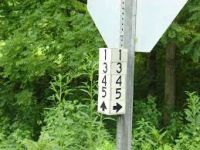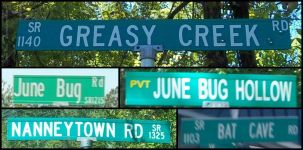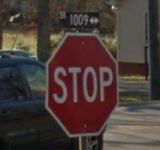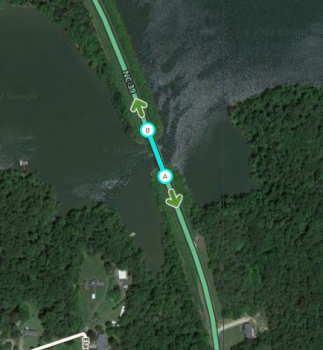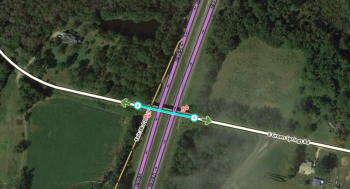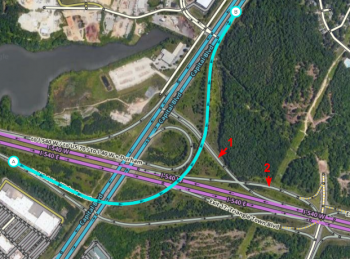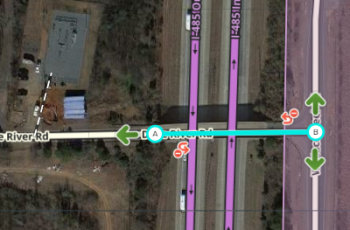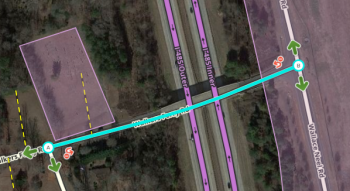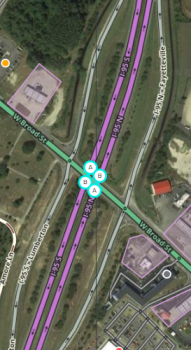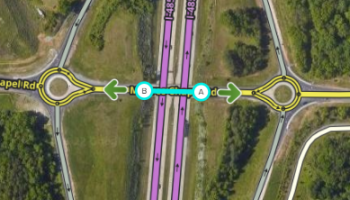| Line 239: | Line 239: | ||
File:Nc-elevation-bad-3.png|'''<u>Bad</u>''': A bridge over a highway between two ramps does not have any destinations and should be one elevated segment: | File:Nc-elevation-bad-3.png|'''<u>Bad</u>''': A bridge over a highway between two ramps does not have any destinations and should be one elevated segment: | ||
</gallery>|steps to create an RPP|nt=yes|summary=Click to expand examples of Good and Bad Elevation}} | </gallery>|steps to create an RPP|nt=yes|summary=Click to expand examples of Good and Bad Elevation}} | ||
===Lane Guidance=== | |||
North Carolina follows national guidance for [[Lanes]]. Contact an [[#Area_Managers|NC SM]] with any questions. | |||
{{mbox | type = warning | text = Do not add lanes to H or # intersections if they are outside of the angles currently allowed by the lanes heuristics. Instead, leave a map comment noting "future lanes" needed.}} | |||
===Road Shields=== | |||
North Carolina follows national guidance for shields and visual turn instructions. | |||
'''Shields on Streets''' | |||
*See [[Shield|Shields]] for US Guidance. | |||
*'''IMPORTANT:''' Only add shields on streets where the primary name matches the shield you intend to add. For example, on a street with a primary name of “US-64 W”, you should add a “US Hwy Main” shield with the number “64” and the direction “Wᴇꜱᴛ” (using the proper small caps). But if a portion of US-64 is named “W Main St”, you will not add the shield to that primary name. | |||
*Instead, in the above example, US-64 should already be an alt name on W Main St, and the shield can/should be added to that alt name. | |||
{{mbox | text = As of January 2022, NC has all of its requested state shields available in WME. If you come across a shield design that is not available, please [[#Area_Manager|contact an SM]].}} | |||
'''Visual Instructions''' | |||
*See [[Turn instruction|Turn Instructions]] for US Guidance. | |||
*If you have any questions about adding turn instructions that include shields, contact an [[#Area_Manager|NC SM]]. | |||
<!---- DO NOT MODIFY BELOW ------ DO NOT MODIFY BELOW ------ DO NOT MODIFY BELOW ---- | <!---- DO NOT MODIFY BELOW ------ DO NOT MODIFY BELOW ------ DO NOT MODIFY BELOW ---- | ||
Revision as of 23:43, 5 March 2022
An exception currently to the USA Roads standard is North Carolina state highways. North Carolina has numbered state highways from Controlled Access Freeways down to Alleys. Because of this, North Carolina strictly uses Functional Classification to set road types for state highways and below.
Road Names
See Road types for general rules where North Carolina does not specifically differ.
| See Military Bases for a complete list of rules for mapping on Military Bases. |
North Carolina has two classes of state funded roads, Primary State Highways, and Secondary Roads (aka State Rte or Road). Please carefully observe the following naming formats for roads in these categories.
Primary State Highways
State Highways are numbers under 1000 (1-3 digits) and bear the NC diamond shield.
- These roads should be named "NC-###"
- Use a single hyphen and no spaces between NC and the route number.
- This applies to both Primary and Alternate road names.
Secondary Roads (aka State Rte or Road)
Secondary Roads are route numbers of 1000 or greater (four digits or more).
- These Roads are not signed with shields. Regular green or white road signs are most commonly used to designate secondary roads.
- On green signs, the prefix "SR" should precede the road number.
- On white signs (commonly attached to stop signs), it will just have the road number. (See pictures above)
- These roads should be named "SR-####" Use a single hyphen and no spaces between SR and the road number.
- These names are typically used as Alternate Road names, along with Primary names which match local road signage.
- SR numbers can be found using the NCDOT Secondary Roads Database Lookup.
NOTE: North Carolina does not use County Road numbers. If found, these should be updated to the Secondary Road format
Road Function Class
See Road types as a general rule.
We have also incorporated the NC Functional Class Map into our road classification system:
This should be the first step in determining the correct road type in WME. The list below are minimums (e.g. a State Highway would be at a minimum a minor highway. It could also be a major highway or freeway depending on functional class).
- Freeway - Interstates and all other roads with no at-grade intersections.
- Major Highway - US Highways, Interstates that have at-grade intersections.
- Minor Highway - State Highways, US Business Highways.
- Primary Street - State Business Highways.
If the road is not defined as one of the above then please use the functional class to determine what type to qualify the road as.
Using the NC Functional Class Map
The NC Functional Class Map is divided into 9 road type classifications. Most road classifications will minimally be defined by the above criteria. For all other roads that do not fit into that criteria, please use the references below:
| Functional Class | Waze Type |
|---|---|
| Interstate | Freeway |
| Other Freeway | Freeway |
| Other Principal Arterial | Major Highway |
| Minor Arterial | Minor Highway |
| Major Collector | Primary Street |
| Minor Collector | Primary Street |
| Local | Street |
Contact an Area Manager or State Manager if you feel there is an exception to these rules. Consistency is key. Do not change a road type for routing sake or to make it appear on the map at a higher speed. Also, do not switch road types every few segments just because the functional class does (Contact an AM or SM for help).
Function Class Quick Reference Chart
Refer to this chart to determine the road type of a given paved public road based on the North Carolina functional class.
To use this chart, first determine the functional class of a road, and whether it is a signed, numbered highway in a particular highway system.
Where the column for the road's highway system and the row for the road's North Carolina functional class meet, you will find the proper road type for that particular road.
| Highway Systems | ||||||||
|---|---|---|---|---|---|---|---|---|
Interstate |
Interstate Business Loop/Spur | US Hwy |
US Hwy BUS, SPUR, LOOP | State Hwy (incl. some special routes) |
State Hwy BUS, SPUR[a], LOOP | Locally-maintained | ||
| example | I-95 N | I-95 Business | US-301 | US-301 Business | NC-87 | NC-87 Business | Robertson St | |
| N C F u n c t i o n a l C l a s s |
Interstate[b] | Fw | n/a | n/a | n/a | n/a | n/a | n/a |
| Other Freeway[c] | n/a | Fw | Fw | Fw | Fw | Fw | Fw | |
| Other Principal Arterial[d] | n/a | Major (MH) | Major (MH) | Major (MH) | Major/MH | Major (MH) | Major (MH) | |
| Minor Arterial[e] | n/a | Major (MH) | Major (MH) | Minor (mH) | Minor (mH) | Minor (mH) | Minor (mH) | |
| Major Collector | n/a | Major (MH) | Major (MH) | Minor (mH) | Minor (mH) | PS | PS | |
| Minor Collector | n/a | Major (MH) | Major (MH) | Minor (mH) | Minor (mH) | PS | PS | |
| Local/not mapped | n/a | Major (MH) | Major (MH) | Minor (mH) | Minor (mH) | PS | Street (St) | |
| Fw | Freeway |
| Major (MH) | Major Highway |
| Minor (mH) | Minor Highway |
| PS | Primary Street |
| Street (St) | Street |
^a When a state highway "SPUR" route is used to connect a state highway with another state highway, a US highway, or an Interstate (i.e., when it is used as a connector/CONN route), use the first state highway column.
^b Also known as Principal Arterial - Interstate.
^c Also known as Principal Arterial - Freeway.
^d Also known as Principal Arterial.
^e Also known as Other Arterial.
Examples
- An Interstate Business Loop classified as a Minor Arterial is a Major Highway .
- A US Highway classified as a Minor Arterial is a Major Highway .
- A US Highway Spur route classified as a Minor Arterial is a Minor Highway .
- A State Highway classified as an Other Freeway is a Freeway .
- A State Highway classified as a Collector is a Minor Highway .
- A locally-maintained road classified as an Other Principal Arterial is a Major Highway .
- A locally-maintained road classified as a Collector is a Primary Street .
Speed Limits
See Speed limits as a general rule.
Do not assume! Know the correct speed limit for a segment before setting a speed limit.
If you do not know the speed limit for a segment leave it blank. It is safer to not set a speed limit then to get it wrong.
North Carolina statutory speed limit laws are:
- Within municipal corporate limits is 35 MPH unless otherwise posted.
- Outside municipal corporate limits is 55 MPH unless otherwise posted.
- Military Installations is 30 MPH unless otherwise posted.
- Interstates (Freeways) all have posted speed limits and a maximum of 70 MPH.
| Road Type | Status |
|---|---|
| Freeway | 100% |
| Major Highway | 100% |
| Minor Highway | 100% |
| Primary Street | 99.3% |
| Street | 26.6% |
| USA Score | 98.5% |
| USA Rank | 10 |
| Updated 2018-08-13 | |
Road Locking
In North Carolina we have a set minimum standard for locking roads based on segment type. Any road of a certain segment type must be locked at least to the rank (level) in the chart below. Roads may be locked higher for protection and special situations (areas with construction, tricky design, frequent mistakes, imaging inaccuracies, and the like), but should not be locked lower.
A great time to implement these locks is while bringing the road types of an area into compliance with the current US road type standards (FC and highway systems). Lock the roads based on type after they've been set to current US road type standards.
| Segment Type | Statewide |
|---|---|
| Freeway | 5 |
| Ramp | Highest rank of connected segment |
| Major Highway | 4 |
| Minor Highway | 3 |
| Primary Street | 2 |
| Street | 1 |
| • • • • Ferry • • • • | 5 |
| |-|-|-|-|-|-|-|-|-| Railroad |-|-|-|-|-|-|-|-|-| | 2 |
Note: Certain areas may be locked higher than the above minimums. Please do not lower locks unless approved by the RC or SM of North Carolina.
Road Elevation
In general, North Carolina only follows “True Elevation” to the extent that negative elevations should only be used for tunnels, and does not follow “Seagull” elevation rules, with some exceptions as described below. This is due in part to issues experienced with exceptionally short segments, and to our state’s unique closures system, where most closures are handled by editors instead of Waze Partners.
General Principles
- Drivable and non-drivable segments are handled the same way with elevation.
- Set elevation to Ground in most cases.
- Only segments passing over other segments shall have higher elevation, relative to ground.
- The entire segment should be elevated between existing junctions with other segments.
- Do not cut segments at the start/end of a bridge (see exceptions below).
- Do not increase elevation on segments passing over water or any other bridge that does not cross other segments (see exceptions below).
- Elevation of overlapping segments should be set relative to each other, with the lowest segment as Ground (unless a tunnel).
- Only set elevation as low/high as necessary (i.e. only set elevation to 2 if passing over a segment set to 1)
- Only tunnel segments should have negative elevation.
Exceptions
In order to allow for proper closure placement, there are exceptions to the above guidance:
- If a navigable destination (i.e. house number or place entry point) exists on a segment that would be elevated, the segment should be cut at the start/end of the bridge/actual elevated portion (unless another junction is located within 60m/200ft).
- Bridges over water on rural, two-way segments should be mapped with cuts at the start/end of the bridge (unless another junction is located within 60m/200ft), and the elevation raised by 1 to suppress “unneeded junction” warnings from scripts.
Reminders
- If you use the Bridge tool to join segments, be aware that it raises the elevation of the joined segment. Lower the joined segment as appropriate.
- Tunnels should be cut at least 15m/50ft before and after the tunnel, to allow time for the GPS to regain signal, and must have the “Tunnel” checkbox selected in addition to negative elevation.
Examples
Lane Guidance
North Carolina follows national guidance for Lanes. Contact an NC SM with any questions.
| Do not add lanes to H or # intersections if they are outside of the angles currently allowed by the lanes heuristics. Instead, leave a map comment noting "future lanes" needed. |
Road Shields
North Carolina follows national guidance for shields and visual turn instructions.
Shields on Streets
- See Shields for US Guidance.
- IMPORTANT: Only add shields on streets where the primary name matches the shield you intend to add. For example, on a street with a primary name of “US-64 W”, you should add a “US Hwy Main” shield with the number “64” and the direction “Wᴇꜱᴛ” (using the proper small caps). But if a portion of US-64 is named “W Main St”, you will not add the shield to that primary name.
- Instead, in the above example, US-64 should already be an alt name on W Main St, and the shield can/should be added to that alt name.
| As of January 2022, NC has all of its requested state shields available in WME. If you come across a shield design that is not available, please contact an SM. |
Visual Instructions
- See Turn Instructions for US Guidance.
- If you have any questions about adding turn instructions that include shields, contact an NC SM.

